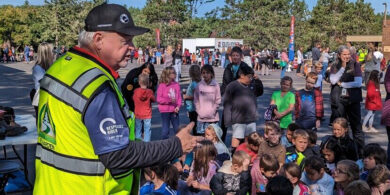Oct. 13, 2008 – More safety efforts proposed
By Mike Davin
contributing writer
The ATV safety bill included in August’s Consumer Product Safety Improvement Act doesn’t represent the end of the government’s interest in ATVs, according to officials at the Consumer Product Safety Commission (CPSC).
Instead, the issue will be an ongoing area of concern as the CPSC endeavors to implement additional programs and standards.
These programs could include more training for consumers, signed acknowledgements from parents about the risks ATVs pose for children and new ATV models for young riders, among other initiatives.
In the short term, the CPSC is working to meet the 90-day deadline it was given by Congress to publish the new mandatory ATV standards in the Federal Register. After that, the organization’s commitment to ATV safety is open-ended, says Scott Wolfson, deputy director in the CPSC’s Office of Information and Public Affairs.
Wolfson says the CPSC has several proposals that are currently under discussion that would venture beyond the scope of the law passed in August.
One proposal would provide free training to everyone who purchases an ATV, which would include adults as well as children if a youth model is purchased.
Like other proposals under discussion, details have not been ironed out yet, but the training would be done mainly through manufacturers, as well as the ATV Safety Institute and some states that have the necessary infrastructure in place. Funding for the program would come from manufacturers and dealerships.
Another proposal would require the adult purchaser of an ATV to sign an acknowledgement at the point of sale that says they understand how dangerous ATVs can be for a young person who does not follow recommended safety guidelines.
A third proposal would expand the types of available youth ATV models currently available . The standards proposed by the CPSC differ from those recognized by the Specialty Vehicle Institute of America, by recommending slightly lower speeds along with potentially slightly heavier vehicles.
The CPSC would like to see three models, broken down using the 6-8, 9-11 and 12-15 age groups as a guide. Ratings for these models would be based on maximum speed rather than horsepower, with the model for 6- to 8-year-olds starting at 10 mph.
The model for 12- to 15-year-olds would have a maximum speed of 30 mph, but it would come off the line running at 15 mph and parents would have the ability to increase the maximum speed when they believe their children are properly prepared.
The CPSC also wants to work with manufacturers to create a model for 12- to 15-year-olds that fits them better. According to Wolfson, children in this age range need an ATV that is a little wider and a little taller than what is currently available on the market, which will give them more space to fit on the vehicle properly — without making the vehicle so large that children are riding adult-sized ATVs.
In addition to these proposals, the CPSC will continue to support its other ATV-related programs as well.
That includes the CPSC’s ongoing education and awareness efforts, such as its Web site, atvsafety.gov, as well as a rapid response program that’s modeled after a U.S. Fire Administration initiative.
The rapid response program, which started in the spring of 2007, targets the media by providing quick fact sheets in the event of ATV-related accidents.
These releases include news that is specific to the incident in question, as well as relevant contextual information. This includes items such as data on fatalities or material about the dangers of riding on paved roads if that is where the accident took place.
“The goal is to decrease the number of ATV-related deaths by making communities more aware of what is happening,” said Sonia Hayes-Pleasant, a public affairs specialist with the CPSC.
The estimated number of ATV-related deaths reported on the CPSC’s Web site has increased steadily during the past decade, going from 536 in 1999 to 870 in 2005, the last year for which an estimate is given.
The CPSC is committed to investigating every ATV death in the country, according to Wolfson. These investigations, which are sometimes on site and other times based on police and medical reports, are intended to give the CPSC better insight into the various causes of ATV accidents.
To that end, the CPSC also conducts ongoing testing at the Aberdeen Proving Grounds in northeastern Maryland — an effort that might soon be aided by a new piece of technology. A robotic “autonomous ATV” is in development, which would allow the CPSC to be able to conduct testing that in the past would have been too dangerous to attempt.
“We want to be able to do the right types of testing, but not put staff at risk,” Wolfson said. “If we need to test a rollover scenario, for example, we wouldn’t have to use a staff member to do that.”
For those interested in learning more about what is currently happening with ATV regulations, the commission is planning to hold a public meeting Oct. 16 to discuss the new mandatory standards for ATVs and the new ATV provisions in the Consumer Product Safety Improvement Act.
The meeting, which will be held from 10 a.m.-3 p.m. at the CPSC offices in Bethesda, Md., is open to anyone who would like to attend, and will also be available for remote viewing via a live Web cast.
For registration and additional information, visit cpsc.gov/cgibin/atv.aspx.




